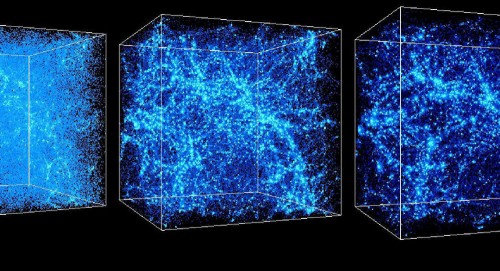Quantum physics has proposed some peculiar theories like the multiverse, in which multiple, if not infinite universes may exist outside our own. But now a cold spot in our universe, originally identified as the Eridanus Supervoid, may actually be hard evidence that a parallel universe bumped into our own. If so, it has some bizarre implications.
The Cosmic Microwave Background
Since the Big Bang occurred, a layer of electromagnetic radiation remains throughout the entirety of our universe, known as the cosmic microwave background, or CMB. Scientists have mapped the CMB as a snapshot of what the universe looked like around 380,000 years old, when it was much hotter – 3,000 K to be precise.
This radiation is measured by its consistent temperature, now somewhere around 2.7 degrees Kelvin. But as scientists studied the CMB, they noticed a spot, some 3.5 billion lightyears wide, that was significantly colder than usual.
Normally, the deviation in temperature throughout the CMB averages around .02 K. But this CMB cold spot is .15 K colder than average, a significant anomaly.
One study believed this area was a supervoid, dubbed the Eridanus Supervoid, where the density of galaxies is significantly lower than the rest of the universe. Throughout space there are superclusters of galaxies connected by filaments. These filaments are thought to consist of dark matter and are the largest known structures in the universe forming boundaries between empty space.
The Eridanus Supervoid was originally believed to be just an empty void of space without any dark matter, but this theory has recently been brought into question. With the way the universe is expanding, galaxies will inevitably form clusters and grow apart from other clusters, given enough time. But with the supervoid, there hasn’t been enough time passed since the Big Bang to account for such a large gap.
Essentially, our knowledge of the way the universe works shouldn’t allow for such a massive void. And the odds of this area being a supervoid have become even less likely as scientists try to replicate the calculations that originally gave it that designation.
Several factors led to this conclusion, like the fact that there isn’t a large enough absence of galaxies for it to be that cold. In fact, the odds of having a cold spot that large are about 1-in-50 universes. Scientists also noticed that the distribution of heat throughout the universe was asymmetrical, with higher than average temperatures located in the southern hemisphere, near this cold spot. This does not fit with cosmology’s standard model which predicts a relatively even distribution throughout the universe.
The Multiverse
Instead of a massive void, an idea made popular by astrophysicist Laura Mersini-Houghton, posits the possibility that the CMB cold spot is the result of a parallel universe that bumped into our own at some point in the past – a concept that many quantum physicists have entertained, but one that is at odds with traditional physics.
But Mersini-Houghton is no stranger to contentious theories. Just a few years ago she sparked controversy in the scientific world when she claimed that black holes do not exist – an idea that contradicted the work of notable astrophysicists like the late Stephen Hawking.
The multiverse, however, is a concept that has a lot of backing by string theorists, including Dr. Michio Kaku, who believes that everything is connected throughout a multitude of universes via vibrating cosmic strings. String theory states that our universe is just one of 10500 possible universes.
Mersini-Houghton is a proponent of the multiverse theory and says she believes the CMB cold spot to be the product of quantum entanglement between our universe and another, before they were separated by cosmic inflation. Einstein referred to this quantum behavior as spooky action at a distant.
String theory is complex, but the basic premise in terms of the multiverse is that the Big Bang was the result of an interaction between multiple universes. With the multiverse theory, a universe can grow new universes or split into two separate universes. This was first proposed by Alan Guth as part of his inflation theory.
Inflation theory is based on the counterintuitive idea that gravity can act as a repulsive force, rather than a purely attractive force. This has been hypothesized in the form of a white hole, the opposite of a black hole. Einstein’s theory of relativity allows for the possibility of white holes, connected to a black hole via a wormhole.
When a black hole pulls in everything around it, it becomes increasingly more dense. The light and matter it sucks in is then transported through a wormhole, before being ejected through a white hole. Kaku and Guth say they believe it’s possible that a white hole shooting out matter from anther universe could have resulted in the Big Bang that created our universe.
Kaku says that one way to conceptualize the multiverse is to picture a fish swimming in a pond. To the fish, reality consists of what it can see and where it can go within its pond. Essentially, it can only swim forward, backward, and side to side. Think of this as the way we currently perceive our universe.
But when the fish is one day lifted out of the pond by a human who breathes air and moves without fins, he is exposed to another dimension where the laws of physics and biology are entirely different from what he thought were the only possibilities of existence. String theorists believe this is a good analogy for other universes that may exist outside of our own. The laws of physics and biology in a parallel universe could be entirely different from everything we know.
In fact, it’s possible there are infinite universes, with infinite realities, in which everything is occurring simultaneously, all connected through vibrating cosmic strings. This would imply that every outcome is happening simultaneously in parallel universes as we live our lives.
Just before he passed away, Hawking published a paper, titled “A Smooth Exit from Eternal Inflation,” with physicist Thomas Hertog, imagining our universe as existing in a multiverse.
Hawking entertained the idea of a multiverse, though he had trouble fathoming the idea that it could be infinite. “Let’s try to tame the multiverse,” Hawking said to Hertog.
So the two ideated ways it could be tested and measured. They then proposed the theoretical possibility of a probe that could search for evidence left behind by a parallel universe. In the paper, they predicted that the probe might be able to find evidence at the outer reaches of our universe such as an imprint left in the CMB.
Could this have been a nod from Hawking to Mersini-Houghton, acknowledging the plausibility of her theory of a parallel universe leaving its mark on our own?





